初中:八年级英语下册Unit5教案
- 格式:docx
- 大小:32.46 KB
- 文档页数:7
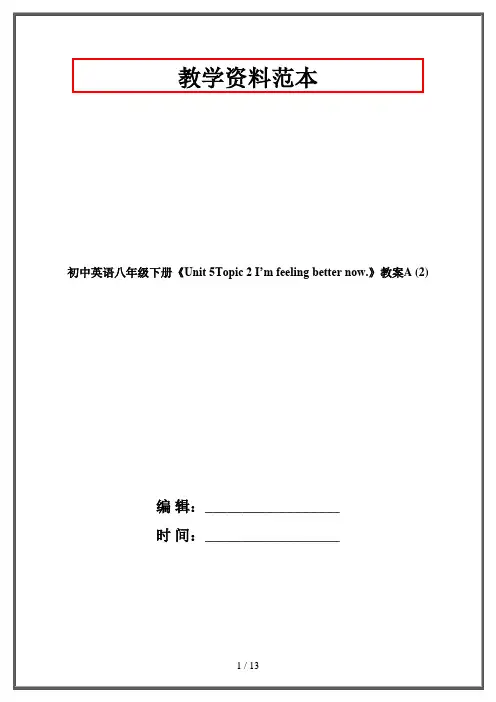
Unit 5 Topic 2 I’m feeling better now SectionAⅠ. Material analysis本节课为话题的第一节课,建议用1课时上完。
主要活动为Section A 的1a和2。
本课通过Miss Wang 询问Helen忧心忡忡的原因,引出对话的主题:学会关爱他人,帮助他人走出情绪低落的阴影,给予心情不好的同伴合理有效的建议。
对话通过询问Helen情绪低落的原因呈现了本课所要学的语法重点:原因状语从句, 并呈现了新出现的短语:be strict with sb. 和beworried about …. 同时在对话中呈现了交际功能用语:Anything wrong?和 What seems to be the problem?使学生在学会运用课本语言知识解决书面问题的同时,提高他们的口语交际技能,真正做到学以致用。
Ⅱ. Teaching aimsKnowledge aims:1. 学生能正确拼读并运用单词表中的黑体单词exam, strict和shy。
2. 学生能正确运用以下短语造句:seem to do…, do badly in…, be strict with sb., have a talk with sb., be worried about…, take it easy3. 学生能自如地运用以下功能句进行交流。
Anything wrong?What seems to be the problem?Thank you for telling me.Skill aims:1. 能听懂有关关注情绪和提出建议的简单对话和陈述。
2. 能正确地运用本课的交际功能用语进行询问和给出建议。
3. 能正确朗读课本的有关情绪询问和给出建议的文本材料及难度相当的材料。
4.能正确地运用本课新呈现的短语,原因状语从句以及交际功能语言写出简单的有关情绪询问和给出建议的对话。
E motional aims:通过对SectionA的学习,学生能够学会关注他人的情绪,在别人情绪低落时提出合理有效的建议,帮助伙伴远离消极情绪。
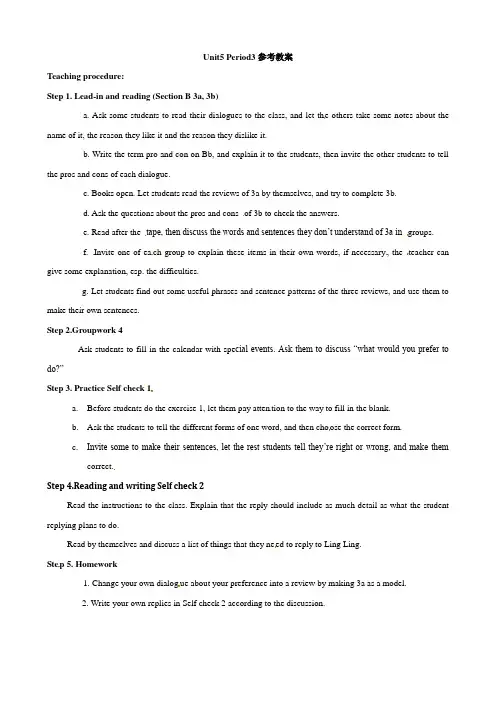
Unit5 Period3参考教案Teaching procedure:Step 1. Lead-in and reading (Section B 3a, 3b)a. Ask some students to read their dialogues to the class, and let the others take some notes about the name of it, the reason they like it and the reason they dislike it.b. Write the term pro and con on Bb, and explain it to the students, then invite the other students to tell the pros and cons of each dialogue.c. Books open. Let students read the reviews of 3a by themselves, and try to complete 3b.d. Ask the questions about the pros and cons of 3b to check the answers.e. Read after the tape, then discuss the words and sentences they don’t understand of 3a in groups.f. Invite one of ea ch group to explain these items in their own words, if necessary, the teacher can give some explanation, esp. the difficulties.g. Let students find out some useful phrases and sentence patterns of the three reviews, and use them to make their own sentences.Step 2.Groupwork 4Ask students to fill in the calendar with spe cial events. Ask them to discuss “what would you prefer to do?”Step 3. Practice Self check 1a.Before students do the exercise 1, let them pay atten tion to the way to fill in the blank.b.Ask the students to tell the different forms of one word, and then cho ose the correct form.c.Invite some to make their sentences, let the rest students tell they’re right or wrong, and make themcorrect.Step 4.Reading and writing Self check 2Read the instructions to the class. Explain that the reply should include as much detail as what the student replying plans to do.Read by themselves and discuss a list of things that they ne ed to reply to Ling Ling.Ste p 5. Homework1. Change your own dialog ue about your preference into a review by making 3a as a model.2. Write your own replies in Self check 2 according to the discussion.。
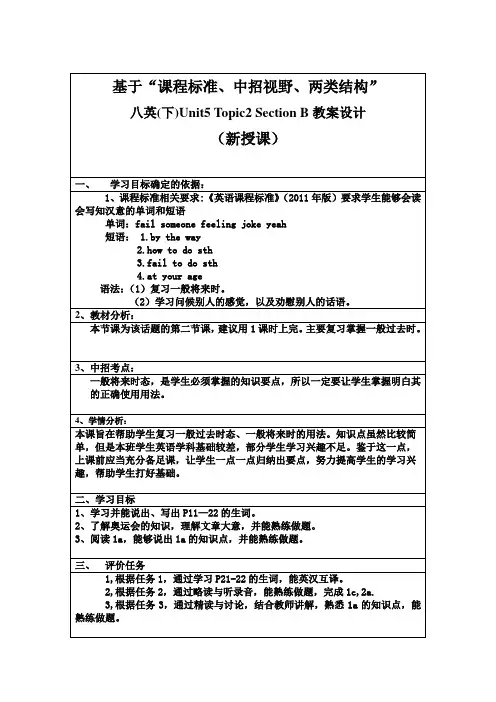
基于“课程标准、中招视野、两类结构”八英(下)Unit5 Topic2 Section B教案设计(新授课)一、学习目标确定的依据:1、课程标准相关要求:《英语课程标准》(2011年版)要求学生能够会读会写知汉意的单词和短语单词:fail someone feeling joke yeah短语: 1.by the way2.how to do sth3.fail to do sth4.at your age语法:(1)复习一般将来时。
(2)学习问候别人的感觉,以及劝慰别人的话语。
2、教材分析:本节课为该话题的第二节课,建议用1课时上完。
主要复习掌握一般过去时。
3、中招考点:一般将来时态,是学生必须掌握的知识要点,所以一定要让学生掌握明白其的正确使用用法。
4、学情分析:本课旨在帮助学生复习一般过去时态、一般将来时的用法。
知识点虽然比较简单,但是本班学生英语学科基础较差,部分学生学习兴趣不足。
鉴于这一点,上课前应当充分备足课,让学生一点一点归纳出要点,努力提高学生的学习兴趣,帮助学生打好基础。
二、学习目标1、学习并能说出、写出P11—22的生词。
2、了解奥运会的知识,理解文章大意,并能熟练做题。
3、阅读1a,能够说出1a的知识点,并能熟练做题。
三、评价任务1,根据任务1,通过学习P21-22的生词,能英汉互译。
2,根据任务2,通过略读与听录音,能熟练做题,完成1c,2a.3,根据任务3,通过精读与讨论,结合教师讲解,熟悉1a的知识点,能熟练做题。
四、教学过程学习目标教学活动评价要点要点归纳目标1.学习并能说出、写出P21—22的生词,并能进行英汉互译自学指导11.自学内容:课本P11—12的生词。
2.自学方法:先根据音标试读,同桌互相正音,提问。
3.自学时间:5分钟4.自学要求:会读,知道其汉语意思,并能英汉互译。
学生看书自学,教师巡视辅导。
自学检测1FailSomeoneFeelingJokeBy the wayyeah1.通过学习P21—22的生词,让学生并能熟练说出、写出P11—12的生词,并能进行英汉互译。
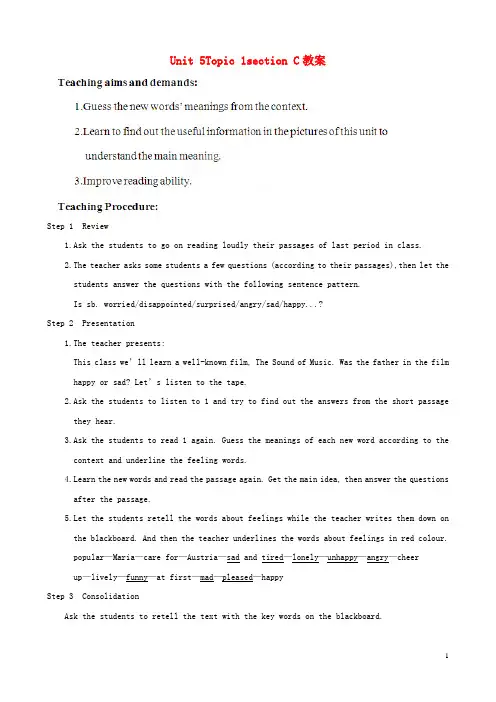
Unit 5Topic 1section C教案Step 1 Review1.Ask the students to go on reading loudly their passages of last period in class.2.The teacher asks some students a few questions (according to their passages),then let thestudents answer the questions with the following sentence pattern.Is sb. worried/disappointed/surprised/angry/sad/happy...?Step 2 Presentation1.The teacher presents:This class we’ll learn a well-known film, The Sound of Music. Was the father in the film happy or sad? Let’s listen to the ta pe.2.Ask the students to listen to 1 and try to find out the answers from the short passagethey hear.3.Ask the students to read 1 again. Guess the meanings of each new word according to thecontext and underline the feeling words.4.Learn the new words and read the passage again. Get the main idea, then answer the questionsafter the passage.5.Let the students retell the words about feelings while the teacher writes them down onthe blackboard. And then the teacher underlines the words about feelings in red colour.popular—Maria—care for—Austria—sad and tired—lonely—unhappy—angry—cheerup—lively—funny—at first—mad—pleased—happyStep 3 ConsolidationAsk the students to retell the text with the key words on the blackboard.Step 4 Practice1.Let the students learn all the words about feelings in 2 once more. Learn new words: nervous,Titanic, America, fall into (fell into), frightened, end, in the end, actor, actress2.Read and finish 2.Step 5 Project1.Talk about their favorite films with the words about feelings learned in groups of four.Finish 3.2.According to 2, write a brief introduction to his/her favorite film.。
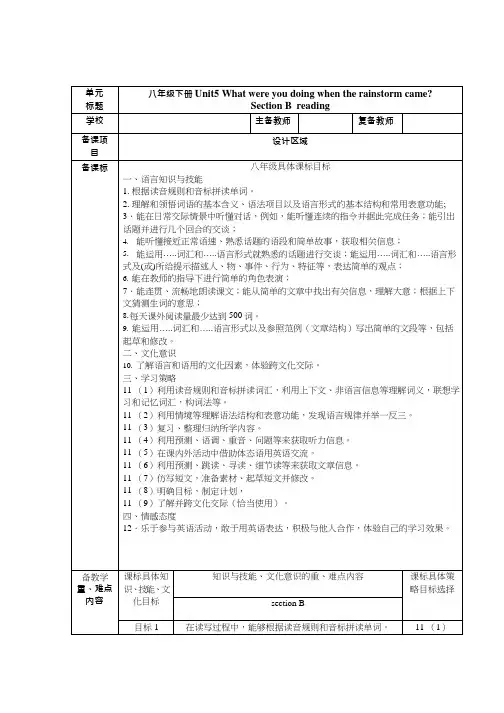
Kate in her office. She was so that 自主学习:从文中寻找答案。
交流探究:小组内合作,统一答案。
综合建模:每个人能够复述这两个故事。
Activity 10 : Terminal group work构建动场:Now , the train is going to the terminal. Let’s have a group work. Four Ss in a group, A is the reporter, B is Robert, C is Kate, D is yourself. Then tell us your story.自主学习:分好角色后,自己练习自己的角色。
交流探究:小组内排练采访。
综合建模:展示采访内容。
Exercise 一.单项选择1.we went to a concert last night. It at seven.Oh, I the clothes at that time.A.Started; washB. starts; was washingC. started; was washingD. was started; was washing2.More and more people the importance of the eco-friendlylifestyle.A.MissB. promiseC. realizeD. suggest3.I have trouble my homework.A.to finishB. finishingC. finishesD. finish4.when did the earthquake in Lushan happen?It happened 8:02 the morning of April 20,2013.A.On, inB. at, inC. at, onD. on, on5.He is to hear the news.A.ShockedB. shockC. shockingD. to shock二.根据汉语意思完成句子。
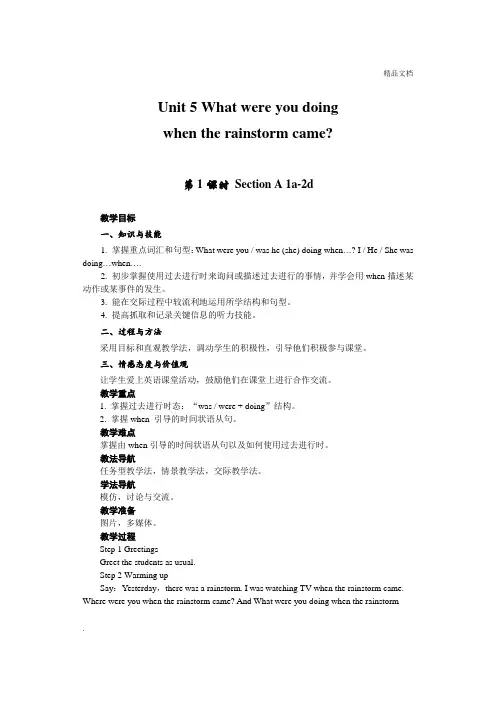
精品文档.Unit 5 What were you doingwhen the rainstorm came?第1课时Section A 1a-2d教学目标一、知识与技能1. 掌握重点词汇和句型:What were you / was he (she) doing when…? I / He / She wasdoing…when….2. 初步掌握使用过去进行时来询问或描述过去进行的事情,并学会用when描述某动作或某事件的发生。
3. 能在交际过程中较流利地运用所学结构和句型。
4. 提高抓取和记录关键信息的听力技能。
二、过程与方法采用目标和直观教学法,调动学生的积极性,引导他们积极参与课堂。
三、情感态度与价值观让学生爱上英语课堂活动,鼓励他们在课堂上进行合作交流。
教学重点1. 掌握过去进行时态:“was / were + doing”结构。
2. 掌握when 引导的时间状语从句。
教学难点掌握由when引导的时间状语从句以及如何使用过去进行时。
教法导航任务型教学法,情景教学法,交际教学法。
学法导航模仿,讨论与交流。
教学准备图片,多媒体。
教学过程Step 1 GreetingsGreet the students as usual.Step 2 Warming upSay:Yesterday,there was a rainstorm. I was watching TV when the rainstorm came. Where were you when the rainstorm came? And What were you doing when the rainstorm精品文档came? Help the students to answer:I was sleeping when the rainstorm came. I was doing my homework when the rainstorm came….Then show some pictures and ask the students:Where were they and what were they doing when the rainstorm came? Work in pairs and ask and answer like this:A:Where were you when the rainstorm came?B:I was in the library.A:What were you doing when the rainstorm came?B:I was reading a book.Step 3 Practice1a, Where were the people at the time of the rainstorm? Match the statements with the people in the picture.1. _____ I was in the library.2. _____ I was in my house.3._____ I was on the street.4._____ I was at the bus stop.Check the answers together.Step 4 Listening1b, What were they doing when the rainstorm came? Let’s listen. R emind the students to pay attention to “was/were +doing”Listen to the TV report and circle the correct responses.a. doing my homework / studyingb. playing basketball / readingc. going to work / waiting for the busd. walking home / shoppingAfter listening,ask some students to report their answers.Step 5 Speaking1c, Look at the pictures and talk about what the people in 1a were doing at the time of the rainstorm using “was/were + doing”.For example:A:What was the boy doing at the time of the rainstorm?B:He was_____________________.Ask some pairs to act out their dialogue.Step 6 Listening2a, First ask the students to look at the pictures and go through the sentences. Then listen and number the pictures 1-5. Play the recording twice if necessary. Then ask some students to report their answers.2b, Listen again. Fill in the blanks in the sentences in 2a. Then ask some students to report their answers.Step 7 Pair work.精品文档. 2c, Use the information in 2a to retell the story in a conversation between the boy and aTV reporter. Then ask some pairs to act out their dialogue. Before they acting,give the “reporter” a “microphone”.2d, Role play the conversation.Step 8 GameAsk the students to practice in groups. One imitates an action and the other two guess by using the dialogue:A:What was he doing when the rainstorm came? B:He was sleeping.Step 9 Summary1. 在图书馆in the library2. 在…的时候at the time of3. 去上班go to work4. 等公共汽车wait for the bus5. 走路回家walk home6. 在街上on the street7. 拾起,接电话pick up 8.(过去)正在做…was / were doingStep 10 Homework1. Remember the words and phrases in this lesson.2. Finish the exercises in the workbook.课堂作业Fill in the blanks according to the conversation in 2d.Mary:What ______ you doing last night,Li nda? I called at seven and you didn’t pick ____.Linda:Oh,I was in the kitchen helping my mom.Mary:I see. I called again at 8 and you didn’t _______ then either.Linda:What was I doing at 8? Oh,I know. When you called,I _____ ______ a shower.Mary:But then I called again at 9.Linda:Oh,I _____ ________ (sleep) at that time.Mary:So early? That’s strange.Linda:Yeah,I was tired. Why _____ you call so many times?Mary:I needed help with my homework. So while you were ________,I called Jenny and she helped me.教学反思教学中,我们可以采用多种手段帮助学生多记单词,多学习语言规则,并尽可能多创造模仿的机会,提高学生的语音和语调。
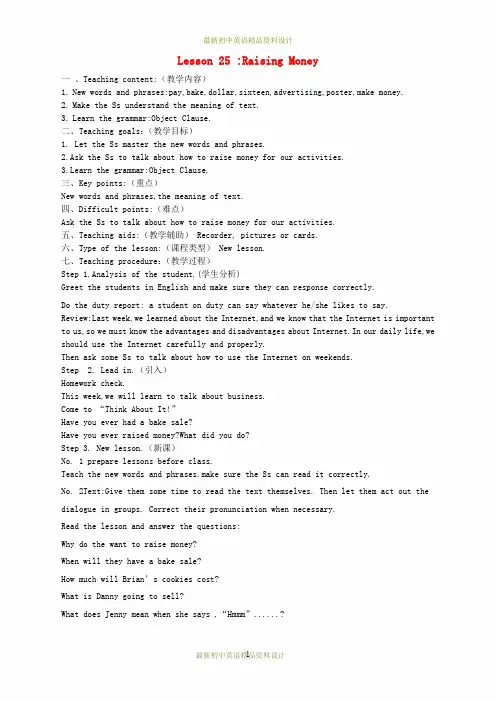
Lesson 25 :Raising Money一、Teaching content:(教学内容)1.New words and phrases:pay,bake,dollar,sixteen,advertising,poster,make money.2.Make the Ss understand the meaning of text.3.Learn the grammar:Object Clause.二、Teaching goals:(教学目标)1. Let the Ss master the new words and phrases.2.Ask the Ss to talk about how to raise money for our activities.3.Learn the grammar:Object Clause.三、Key points:(重点)New words and phrases,the meaning of text.四、Difficult points:(难点)Ask the Ss to talk about how to raise money for our activities.五、Teaching aids:(教学辅助) Recorder, pictures or cards.六、Type of the lesson:(课程类型) New lesson.七、Teaching procedure:(教学过程)Step 1.Analysis of the student.(学生分析)Greet the students in English and make sure they can response correctly.Do the duty report: a student on duty can say whatever he/she likes to say.Review:Last week,we learned about the Internet,and we know that the Internet is important to us,so we must know the advantages and disadvantages about Internet.In our daily life,we should use the Internet carefully and properly.Then ask some Ss to talk about how to use the Internet on weekends.Step 2. Lead in.(引入)Homework check.This week,we will learn to talk about business.Come to “Think About It!”Have you ever had a bake sale?Have you ever raised money?What did you do?Step 3. New lesson.(新课)No. 1 prepare lessons before class.Teach the new words and phrases.make sure the Ss can read it correctly.No. 2Text:Give them some time to read the text themselves. Then let them act out the dialogue in groups. Correct their pronunciation when necessary.Read the lesson and answer the questions:Why do the want to raise money?When will they have a bake sale?How much will Brian’s cookies cost?What is Danny going to sell?What does Jenny mean when she says ,“Hmmm”......?At last,the teacher explain the text in Chinese,make sure the Ss can understand the meaning of text.No. 3 Important notes:1.each+n,everyone/everybody.Eg:Each player needs to pay 150 dollars.I think everybody likes cookies.2.take,pay,spend,cost.No. 4 The Grammar:Object Clause.在句子中起宾语作用的从句叫做宾语从句.宾语从句分为三类:动词的宾语从句,介词的宾语从句和形容词的宾语从句.时态:1·在句子中起宾语作用的从句叫做宾语从句.宾语从句分为三类:动词的宾语从句,介词的宾语主句用一般现在时或将来时,从句可用任意时。
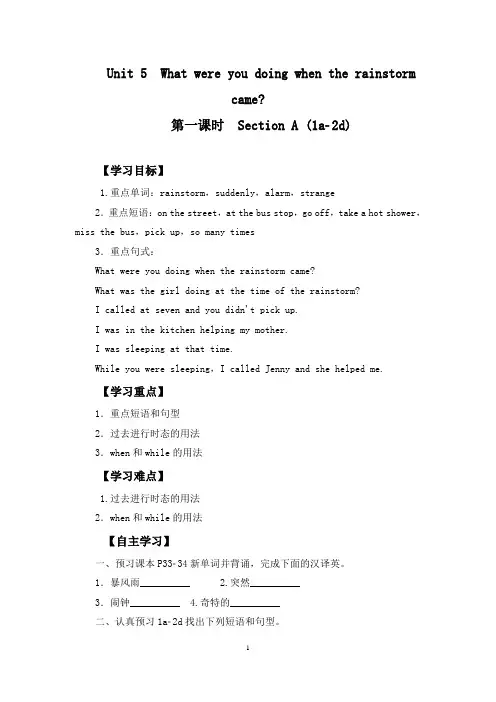
Unit 5 What were you doing when the rainstormcame?第一课时Section A (1a2d)【学习目标】1.重点单词:rainstorm,suddenly,alarm,strange2.重点短语:on the street,at the bus stop,go off,take a hot shower,miss the bus,pick up,so many times3.重点句式:What were you doing when the rainstorm came?What was the girl doing at the time of the rainstorm?I called at seven and you didn't pick up.I was in the kitchen helping my mother.I was sleeping at that time.While you were sleeping,I called Jenny and she helped me.【学习重点】1.重点短语和句型2.过去进行时态的用法3.when和while的用法【学习难点】1.过去进行时态的用法2.when和while的用法【自主学习】一、预习课本P3334新单词并背诵,完成下面的汉译英。
1.暴风雨__________ 2.突然__________3.闹钟__________ 4.奇特的__________二、认真预习1a2d找出下列短语和句型。
1.在街上2.在公共汽车站3.洗热水澡4.错过汽车5.接电话6.这么多次7.暴风雨来临的时候你正在做什么?8.我七点打了电话,但是你没有接。
9.我在厨房给我妈妈帮忙。
10.我那时在睡觉。
11.当你睡觉的时候,我给Jenny打了电话,她帮助了我。
【课堂导学】Step 1情景导入The teacher points at a girl in the classroom and asks:Teacher:Where are you?Student 1:I am in the classroom...Teacher:What are you doing?Student 1:I am answering your questions.The teacher writes “What are you doing?”on the blackboard and asks in Chinese:这是什么时态?引导学生回答,复习现在进行时态的意义及结构。
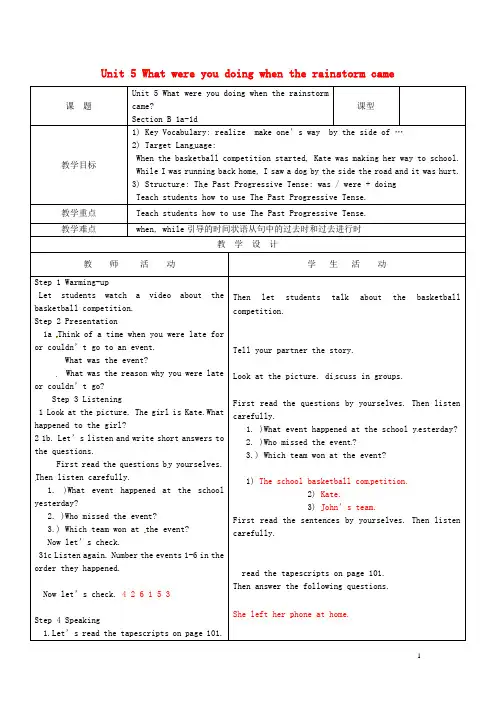
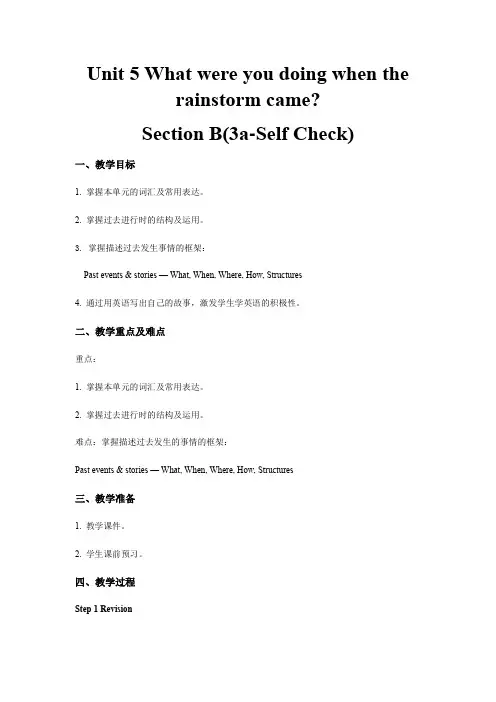
Unit 5 What were you doing when therainstorm came?Section B(3a-Self Check)一、教学目标1. 掌握本单元的词汇及常用表达。
2. 掌握过去进行时的结构及运用。
3. 掌握描述过去发生事情的框架:Past events & stories — What, When, Where, How, Structures4. 通过用英语写出自己的故事,激发学生学英语的积极性。
二、教学重点及难点重点:1. 掌握本单元的词汇及常用表达。
2. 掌握过去进行时的结构及运用。
难点:掌握描述过去发生的事情的框架:Past events & stories — What, When, Where, How, Structures三、教学准备1. 教学课件。
2. 学生课前预习。
四、教学过程Step 1 RevisionComplete and reviewT: Hello, everyone! This is the last lesson of Unit 5. What were you doing when the rainstorm came? Do you still remember the two important events in American history we learned last time? So, you are going to read and complete the sentences according to the passage.设计意图:从做题入手,引起学生对所学知识的回顾,为本课时的综合复习和输出做好准备。
Step 2 Pre-writingMake notesT: There’re many things happened around us in the past. Do you still remember an event well? What was the event? When did it happen? And where? Here’re seven questions. Think and try to make notes or write sentences about it.设计意图:发散学生的思维,拓宽他们的思考空间,强化运用目标语言。
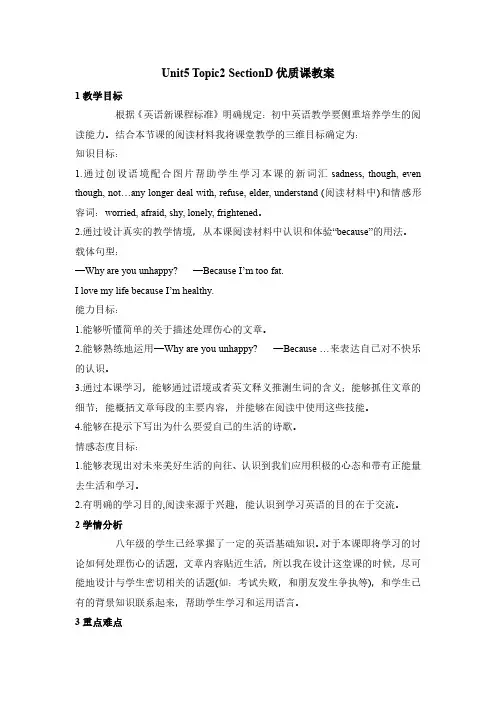
Unit5Topic2SectionD优质课教案1教学目标根据《英语新课程标准》明确规定:初中英语教学要侧重培养学生的阅读能力。
结合本节课的阅读材料我将课堂教学的三维目标确定为:知识目标:1.通过创设语境配合图片帮助学生学习本课的新词汇sadness,though,even though,not…any longer deal with,refuse,elder,understand(阅读材料中)和情感形容词:worried,afraid,shy,lonely,frightened。
2.通过设计真实的教学情境,从本课阅读材料中认识和体验“because”的用法。
载体句型:—Why are you unhappy?—Because I’m too fat.I love my life because I’m healthy.能力目标:1.能够听懂简单的关于描述处理伤心的文章。
2.能够熟练地运用—Why are you unhappy?—Because…来表达自己对不快乐的认识。
3.通过本课学习,能够通过语境或者英文释义推测生词的含义;能够抓住文章的细节;能概括文章每段的主要内容,并能够在阅读中使用这些技能。
4.能够在提示下写出为什么要爱自己的生活的诗歌。
情感态度目标:1.能够表现出对未来美好生活的向往、认识到我们应用积极的心态和带有正能量去生活和学习。
2.有明确的学习目的,阅读来源于兴趣,能认识到学习英语的目的在于交流。
2学情分析八年级的学生已经掌握了一定的英语基础知识。
对于本课即将学习的讨论如何处理伤心的话题,文章内容贴近生活,所以我在设计这堂课的时候,尽可能地设计与学生密切相关的话题(如:考试失败,和朋友发生争执等),和学生已有的背景知识联系起来,帮助学生学习和运用语言。
3重点难点教学重点:1.通过自制视频中的语境、联系阅读文章中的句子推测生词的英文释义。
2.帮助学生掌握基本的阅读技巧如:通过抓住每段的首尾句概括每段大意,通过图片预测文章大意的能力,猜测生词意义的能力,以及在细读的时候找到答案的相关点。
Unit5 Topic3 SectionA优质课教案教学设计思路:本节课主要活动为Section A -1a。
本节课的课型为听说课。
学习新词汇test, nervous, speech, CD的同时掌握描述心情、询问心情、表示安慰和提出建议的功能句,并让学生能够利用这些功能句进行日常交流。
因为1a是一个打电话的对话,所以在复习环节,我们设置情境复习打电话的常用功能句,情境的主要内容也是表达关心,目的是能够呈现并让学生感知目标语言。
Pre-listening的主要任务是学习新词汇和预测1b答案。
本课的词汇不多而且简单,While-listening环节里,除了听1a并完成1b,1c的任务之外,通过师生讨论的方式强化和巩固本课需要学生掌握的功能句,为接下来的交流做准备。
在Post-listening环节里,学生模仿语音语调,选择情境自编对话。
在提高学生的书面表达能力的同时教给学生学习策略:发表演讲或汇报之前要做好充分的准备。
Ⅰ. Teaching aims1. Knowledge aims:(1)学习并掌握新词汇:test, nervous, speech, CD(2)掌握以下描述心情、询问心情、表示安慰和提出建议的功能句:I’m worried.I get so nervous when I give a speech. Is there anything wrong? Relax, I am sure you will do well. I will help you.2. Skill aims:(1) 能听懂有关询问影响心情的事情和提出建议的简单对话和陈述。
(2) 能正确地运用本课的交际功能用语描述心情、询问心情、表示安慰和提出建议。
3. Emotional aims:(1) 通过对本课的学习,学生能够在英语学习中注意并理解他人的情感,在别人心情不好时提出合理有效的建议,帮助伙伴远离消极情绪。
人教版英语八年级下册教案:Unit5 SectionA(3a-4c)Unit5 SectionA(3a-4c)名师教案1.0Teaching analysis教情分析1.1Teaching objectives 教学目标1.1.1Language goals 语言目标1.1.1.1Key Words and Chunks1.1.1.1.1For applying: storm, wind, light, report, area, wood,window, match, beat, against, asleep, rise, fallen, icy,kid, feel like, in the area, beat against, at first, fallasleep, die down, in a mess, wake up, make sure, intimes of, right away, have a look, in bad shape1.1.1.1.2For comprehending: flashlight, apart, Alabama1.1.1.2Sentence Structures1)With no light outside, it felt like midnight.2)After dinner, they tried to play a card game, but it was hard to have fun with a serious storm happening outside.3)Although the storm broke many things apart, it brought families and neighbors closer together.4)He finally fell asleep when the wind was dying down at around 3:00 a.m.5)How can we help each other in times of difficulty?1.1.1.3Grammar Focus1)Black clouds were making the sky very dark. (过去进行时描述过去某个时刻正在发生的动作或存在的状态,结构是“was/were+现在分词”)2)Ben’s dad was putting pieces of wood over the windows while his mom was making sure the flashlights and radio wereworking. (while 表示“当……时候,与……同时”,引导时间状语从句,从句多用进行时态,主句多用一般过去时或过去进行时。
Unit5Topic3SectionA优质课教案教学设计思路:本节课主要活动为Section A-1a。
本节课的课型为听说课。
学习新词汇test,nervous,speech,CD的同时掌握描述心情、询问心情、表示安慰和提出建议的功能句,并让学生能够利用这些功能句进行日常交流。
因为1a是一个打电话的对话,所以在复习环节,我们设置情境复习打电话的常用功能句,情境的主要内容也是表达关心,目的是能够呈现并让学生感知目标语言。
Pre-listening的主要任务是学习新词汇和预测1b答案。
本课的词汇不多而且简单,While-listening环节里,除了听1a并完成1b,1c的任务之外,通过师生讨论的方式强化和巩固本课需要学生掌握的功能句,为接下来的交流做准备。
在Post-listening环节里,学生模仿语音语调,选择情境自编对话。
在提高学生的书面表达能力的同时教给学生学习策略:发表演讲或汇报之前要做好充分的准备。
Ⅰ.Teaching aims1.Knowledge aims:(1)学习并掌握新词汇:test,nervous,speech,CD(2)掌握以下描述心情、询问心情、表示安慰和提出建议的功能句:I’m worried.I get so nervous when I give a speech.Is there anything wrong?Relax,I am sure you will do well.I will help you.2.Skill aims:(1)能听懂有关询问影响心情的事情和提出建议的简单对话和陈述。
(2)能正确地运用本课的交际功能用语描述心情、询问心情、表示安慰和提出建议。
3.Emotional aims:(1)通过对本课的学习,学生能够在英语学习中注意并理解他人的情感,在别人心情不好时提出合理有效的建议,帮助伙伴远离消极情绪。
(2)学会勇于克服困难。
(3)对朋友的询问、关心等作出恰当的反应。
Unit 5 What were you doing when the rainstorm came
第1课时 Section A 1a-2d 教学目标 一、知识与技能 1. 掌握重点词汇和句型:What were you / was he (she) doing when… I / He / She was doing…when…. 2. 初步掌握使用过去进行时来询问或描述过去进行的事情,并学会用when描述某动作或某事件的发生。 3. 能在交际过程中较流利地运用所学结构和句型。 4. 提高抓取和记录关键信息的听力技能。
二、过程与方法 采用目标和直观教学法,调动学生的积极性,引导他们积极参与课堂。 三、情感态度与价值观 让学生爱上英语课堂活动,鼓励他们在课堂上进行合作交流。 教学重点 1. 掌握过去进行时态:“was / were + doing”结构。 2. 掌握when 引导的时间状语从句。 教学难点 掌握由when引导的时间状语从句以及如何使用过去进行时。 教法导航 任务型教学法,情景教学法,交际教学法。 学法导航 模仿,讨论与交流。 教学准备 图片,多媒体。 教学过程 Step 1 Greetings Greet the students as usual. Step 2 Warming up Say:Yesterday,there was a rainstorm. I was watching TV when the rainstorm came. Where were you when the rainstorm came And What were you doing when the rainstorm came Help the students to answer:I was sleeping when the rainstorm came. I was doing my homework when the rainstorm came…. Then show some pictures and ask the students:Where were they and what were they doing when the rainstorm came Work in pairs and ask and answer like this: A:Where were you when the rainstorm came B:I was in the library. A:What were you doing when the rainstorm came B:I was reading a book. Step 3 Practice 1a, Where were the people at the time of the rainstorm Match the statements with the people in the picture. 1. _____ I was in the library. 2. _____ I was in my house. I was on the street. I was at the bus stop. Check the answers together. Step 4 Listening 1b, What were they doing when the rainstorm came Let’s listen. Remind the students to pay attention to “was/were +doing” Listen to the TV report and circle the correct responses. a. doing my homework / studying b. playing basketball / reading c. going to work / waiting for the bus d. walking home / shopping After listening,ask some students to report their answers. Step 5 Speaking 1c, Look at the pictures and talk about what the people in 1a were doing at the time of the rainstorm using “was/were + doing”. For example: A:What was the boy doing at the time of the rainstorm B:He was_____________________. Ask some pairs to act out their dialogue. Step 6 Listening 2a, First ask the students to look at the pictures and go through the sentences. Then listen and number the pictures 1-5. Play the recording twice if necessary. Then ask some students to report their answers. 2b, Listen again. Fill in the blanks in the sentences in 2a. Then ask some students to report their answers. Step 7 Pair work 2c, Use the information in 2a to retell the story in a conversation between the boy and a TV reporter. Then ask some pairs to act out their dialogue. Before they acting,give the “reporter” a “microphone”. 2d, Role play the conversation. Step 8 Game Ask the students to practice in groups. One imitates an action and the other two guess by using the dialogue:A:What was he doing when the rainstorm came B:He was sleeping. Step 9 Summary 1. 在图书馆 in the library 2. 在…的时候 at the time of 3. 去上班 go to work 4. 等公共汽车wait for the bus 5. 走路回家walk home 6. 在街上on the street 7. 拾起,接电话 pick up 8.(过去)正在做… was / were doing Step 10 Homework 1. Remember the words and phrases in this lesson. 2. Finish the exercises in the workbook. 课堂作业 Fill in the blanks according to the conversation in 2d. Mary:What ______ you doing last night, Linda I called at seven and you didn’t pick ____. Linda:Oh,I was in the kitchen helping my mom. Mary:I see. I called again at 8 and you didn’t _______ then either. Linda:What was I doing at 8 Oh,I know. When you called,I _____ ______ a shower. Mary:But then I called again at 9. Linda:Oh,I _____ ________ (sleep) at that time. Mary:So early That’s strange. Linda:Yeah,I was tired. Why _____ you call so many times Mary:I needed help with my homework. So while you were ________,I called Jenny and she helped me. 教学反思 教学中,我们可以采用多种手段帮助学生多记单词,多学习语言规则,并尽可能多创造模仿的机会,提高学生的语音和语调。在英语学习中,听、说、读、写、译五种能力是可以互补的。真正做到听说先行,读写跟上。光听说不读写,很难收到高效。只靠模仿不培养学习能力,也难减轻学习负担。
基于“课程标准、中招视野、两类结构”八(下)Uni5Topic1 Section D教案设计(新授课)修订人:王轶斌一、学习目标确定的依据:1、课程标准相关要求:《英语课程标准》(2011年版)要求学生能够会读会写知汉意的单词和短语单词:role facial painting gesture frightened worried interested upset 短语:1. in the end= at last = finally at the end of… 在……的尽头by the end of…到……末为止2. be full of be filled with fill …with…3. make peace with sb.4.play a role语法:掌握Linking verb +adj.的用法。
2、教材分析:本节课为该话题的第四节课,建议用1课时上完。
主要是通过阅读1a, 使学生了解初步了解中国京剧的相关知识,并复习总结了“系表结构”的用法。
3、中招考点:“系动词+形容词”的系表结构及用法。
4、学情分析:“系动词+形容词”的系表结构及用法。
虽然比较简单,但是本班学生英语学科基础较差,部分学生学习兴趣不是很足,有些学生甚至不知道什么是系动词。
鉴于这一点,上课前应当充分备足课,知识点应让学生一点一点地归纳出来,努力提高学生的学习兴趣,帮助学生打好基础。
二、学习目标1、归纳总结本话题所学的有关“系表结构”的句型及交际用语.2、会读,会写P7—8的生词,并能进行英汉互译。
3、熟读1a,能说出1a中的重点短语,重点学习“系表结构”,并会灵活运用。
三、评价任务1、针对目标1,通过学习P6—7的生词,让学生并能熟练说出、写出P6—7的生词,并能进行英汉互译。
2、针对目标2,通过熟读1a,能够说出1a的知识点,并能够运用“系表结构”熟练做题。
四、教学过程学习目标教学活动评价要点要点归纳目标1归纳总自学指导1自学内容:归纳总结本话题学的“系表结构”的句型和交际用语.2.自学方法:同桌互相讨论.1.学生通过复习P7-8Grammar部分,连系动词的分类:1表示“是”的系动词be,表示主语的特征、结本话题所学的有关“系表结构”的句型及交际用语.3.自学时间:5分钟4.自学要求:熟记并能正确使用,完成Functions.Step4自学检测1选词并用其适当形式填空taste ,go look sound smell well1.The roast duck _______ delicious.2.The mother nearly _______ madwhen she heard her son was lost.3.What’s wrong with her ? She______ so sad.4.–Let’s go to the mus eumtomorrow.– That _______ great.5.The rubbish ________ terrible.6.The flower smells _______ and Ilike it very much能够总结“系表结构”的用法,并能熟练做题。
Section BSection B needs 1 period. Section B需用1课时。
The main activities are 1a and 2a. 本课重点活动是1a和2a。
Ⅰ. Aims and demands 目标要求1. Learn some new words:feeling, fail, experience, suggestion, norm al, soft, nervous2. Learn some sentences of reas suring others:Don’t worry.There, there! It’ll be OK.3. Learn how to give advice to people in bad moods.4. Learn to deal with unhappy feelings.Ⅱ. Teaching aids 教具录音机/小黑板/简笔画Ⅲ. Five-finger Teaching Plan 五指教学方案Step 1 Review 第一步复习(时间: 6分钟)复习并导入1a。
1. (运用简笔画复习表示情感的形容词和原因状语从句。
)T: Look at the stick figures, and then review the adjectives expressing feelings and adverbial clauses of reason.2. (教师根据第三幅简笔画,引入新课学习并掌握生词fail和feeling。
)T: Let’s look at Picture 3. What’s wrong with the girl?Ss: She is crying.T: Why?Ss: Because she did badly in the English exam.T: Yes, she didn’t pass her exam. That’s to say, she failed the exam. What’s her feeling? Or how does she feel?Ss: She feels very sad.(板书画线部分。
初中英语新课程标准教材 英 语 教 案
( 2019 — 2020学年度第二学期 ) 学 校: 年 级: 任 课 教 师:
英语教案 / 初中英语 / 八年级英语教案 编订:XX文讯教育机构 初中英语教案 文讯教育教学设计
第 2 页 共 7 页 八年级英语下册Unit5教案
牛津初中英语8b unit5单元知识点复习 1. remember to do sth. 记得要做某事 remember doing sth. 记得做过某事 remember____ (turn) off the lights before you leave the classroom. don’t worry , i remember ____(buy) the book for you yesterday. 2.forget /left a: i’m sorry i____ my homework at home. b: never mind ,but don’t _____to bring it tomorrow. 3. a) be / get used to sth/doing sth.习惯于做某事 be not used to doing sth/ sth eg: (1) 你将很快习惯这儿的生活方式. you will soon ____ ____ ____ ____ _____here. (2) 我不习惯喝酒. i ___ ____ ____ ____ _____the wine. b) used to do sth 过去经常做某事(现在不做了) 否定形式: didn’t use ,或 usedn’
教材简介:本教材主要用途为通过学习英语的内容,提高学生的语言技能,增加一项语言能力,有利于国际化的日常交流、生活、工作等,本教学设计资料适用于初中八年级英语科目, 学习后学生能得到全面的发展和提高。本内容是按照教材的内容进行的编写,可以放心修改调整或直接进行教学使用。 初中英语教案 文讯教育教学设计
第 3 页 共 7 页 t 但反意疑问句用didn’t 1. i was a student in this school in the past. =i ____ ___ ___a student in this school. 2. he used to smoke a lot,_____ ____? c) be used to do sth被动语态,被用于做某事, =be used for doing sth (1) metal is used to make machines.=metal __ ___ ___ ___machines (2) knives are used to cut things.=knives ____ ___ ____ ___things. 练习: (1). my friend gets used to ____(come) to school at 7 in the morning every day. (2). tom said he used to _____(do) some cooking when he lived alone last year. (3). are you used to _____ (eat) vegetables or meat? (4). used he to ____(finish) his task on time? (5). is the cup used to __¬¬_____(drink) water? 4.too…to & so…that & …enough to do … 这个盒子太重了,我搬不动。 初中英语教案 文讯教育教学设计
第 4 页 共 7 页 the box is _____heavy ____i can’t carry _____. the box is ____heavy _____ _____to carry. the box _____ _____ _____for me to carry. 5.carry on with sth. & carry on doing sth. =continue to do sth eg; all we need is enough money to carry on with (doing)our work . 6.be proud of sth /doing sth be proud to do sth . be proud +that 从句 我自豪我是中国人。 i’m proud ____ _____a chinese./ ____ _____a chinese. /_____ ____ a chinese. 7. teach sb sth. & teach sb. to do sth. & teach oneself sth.==learn sth. by oneself 刘老师教我英语。 mr liu _____ _____english. 去年,他自学法语。last year ,he ____ _____ french. last year ,he ____ french ____ _____. 你能教我游泳吗? can you teach me ____ _____? 8.so & such so: a. so +adj. +a/an +可数n 单数 b. so + adj./adv. c. so many/much/few/little + n. 初中英语教案 文讯教育教学设计
第 5 页 共 7 页 such : a. such+ a/an +adj. +可数n 单数 b. such +adj. +可数n复数 c. such +adj. + 不可数n (1)this film is so interesting that i like it very much. this is ____ _____ ____film that i like it very much. (2) these flowers are so beautiful that i want to buy them. these are _____ ____flowers that i want to buy them. 9. v-----n. a. +ment b.+ion c.去e+ion d.改e为a+tion adj.---n. a.+ness b.改y为i+ness (1)move_____(2)treat____ (3)develop____(4)improve_____ (5)agree ____(6)advertise_____(7)ill _____ (8) busy ____ (9)useful____(10)gentle_____(11)kind_____(12)sad ____ (13) sick _____( 14) glad ____(15)prevent ____ (16)collect_____ (17)educate_____ (18)donate ____ (19) organize____ (20)examine _____ 10. prevent sb (from )doing sth stop sb (from )doing sth keep sb from doing sth ( )today the forests are getting fewer and fewer. we must ___down too many trees. 初中英语教案 文讯教育教学设计
第 6 页 共 7 页 a. keep people from cutting b. prevent people from cutting c. stop people cutting d. all the above 11.treat ---- 强调动作----treatment cure -----强调结果 (1)the doctor is____ his toothache. i think he will be well after the ____. (治疗) (2)sick people can ____(治愈)by the voluntary doctors.. (3)the students in our school are often_____(对待) with kindness. 12.operate (v.)--- operation(n.) operate on sb. perform / do an operation on sb. (1).____ on patients with eye problem is very difficult. (2).the doctors must prepare a lot before the _____. (手术) 1.他的病如此严重以至于没人能治好他。 ______ ___ _____ 2,他现在已习惯了一个飞行医生的生活方式。 ______ _____ _____ 3,现代医学发展得如此快以至于医生们有必要不断地学习。 ________ 初中英语教案 文讯教育教学设计
第 7 页 共 7 页 4,马医生已经做了如此重要的一份工作以至于人们必须真的感激他。 _________ 5,我过去常常把零花钱用在衣服和零食上. _________
XX文讯教育机构 WenXun Educational Institution